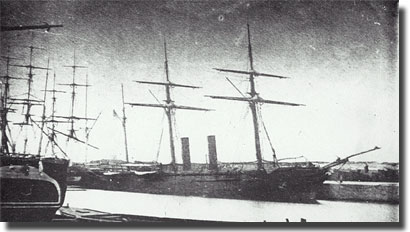|
Marauders of the Sea, Confederate Merchant Raiders During the American Civil War
CSS Rappahannock 1863-1865. Captains. William P.A.Campbell. Charles M. Fauntleroy. CSS Rappahannock.
The British Company Gordon Coleman and Company, acting as an agent for Thomas Bold offered to buy Victor from the Admiralty, and no objections were raised. The ship was cleared to sail on the 23rd. of November, in the English Channel, Lieutenant William P.A. Campbell went aboard and commissioned her as Civil War P 91. CSS Rappahannock. But her Captain found the boilers were totally unreliable, and he went into Calais on the 27th. of November, sending off a telegram to Maury reporting his views on the boilers, and claiming the ship “ unseaworthy.” Maury now sent Lieutenant William F. Carter off to Calais to find out what might be done, and turned over responsibility for this ship to Flag Officer Barron, with Maury no longer having any thing to do with this vessel, and an application was made to the French to carry out repairs necessary to make the ship seaworthy. Now Barron decided to take the guns from Georgia, and mount them in Rappahannock, and Campbell was ordered when ready for sea to meet Georgia, transfer her armament, and then cruise against the enemy’s commerce. The French were not convinced that the ship had entered Calais in distress, and the Americans were going to lay the blame on the French for any American ships that Rappahannock destroyed after taking over Georgia’s armament. The French Foreign Minister, Drouyn de Lhuys ordered the port officials to detain the ship, until the Minister of Marine changed that order. Mallory believed that Campbell was lingering longer than he needed to at Calais, and had him relieved by Lieutenant Charles M. Fauntleroy on the 21st. of March. The various Captains appointed to this ship were not having much success in taking her out to sea to fight, the very purpose for which she had been acquired. Fauntleroy now inspected his new command, and also declared her unseaworthy, no wonder the English got rid of her was his comment, he only had 12 deck hands. Barron never ventured to inspect the ship himself, and closed his eyes to all the reported deficiencies, and was determined to sail her. The French still detained Rappahannock, and she still had not acquired Georgia’s armament, and Fauntleroy advised Barron that the Georgia’s guns were too light for his ship anyway. Bulloch also felt that the Confederate cause would best be served if the ship was sold, this would also appease the French, but Barron was using John Slidell to pressure the French Foreign Minister to release the ship from custody. Fauntleroy sided with Bulloch, but Barron was adament, on the 16th. of May he wrote: Rest assured that I alone, as the senior naval officer abroad, am responsible for the course pursued towards the French Government with reference to the Civil War P 92. the Rappahannock, which you command.” Slidell going over the head of the French Foreign Minister straight to Napoleon III, tried to get the ship released, but Drouyn de Lhuys was strongly enough entrenched in his portfolio to beat this move. On the 9th. of June, Slidell again appealed to Drouyn de Lhuys to release the Confederate ship, all to no avail, and Union agents were wooing away the ship’s crew, total disaster. Barron at last conceded defeat, and told Fauntleroy to pay off the remaining crew, and lay up the ship, she remained until July of 1865, was sold to the US and went off to Liverpool. The whole transaction had become a shambles, and neither Georgia or Rappahannock performed any real service for the Confederacy. Maury did not have sufficient experience to fit out the ships he purchased, and Mallory’s bid to get rid of this prickly Naval Officer backfired to the absolute detriment of the Confederate Navy. No doubt Maury should have been told to use the expertise of Bulloch, who should have been given authority to coordinate these acquistions with his own work on successful ships like Florida, and Alabama. Maury was a scientist, not a purchaser and fitter out of commerce raiders, he left the purchases to friends, and much of the blame for his shortcomings and the failure of his two ship buys, should, I suggest, be laid at Mallory’s door.
back to Confederate Merchant Raiders index |

